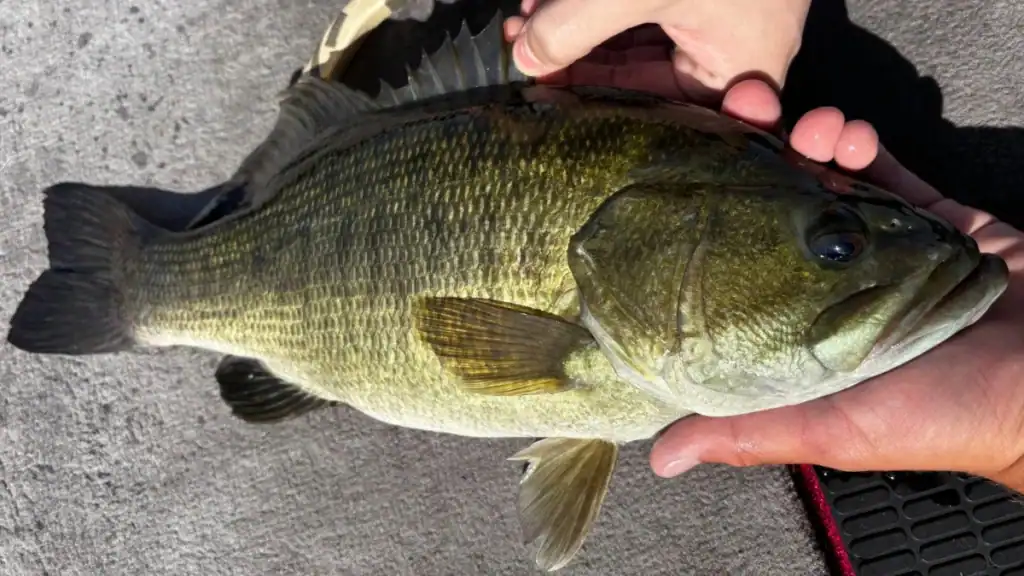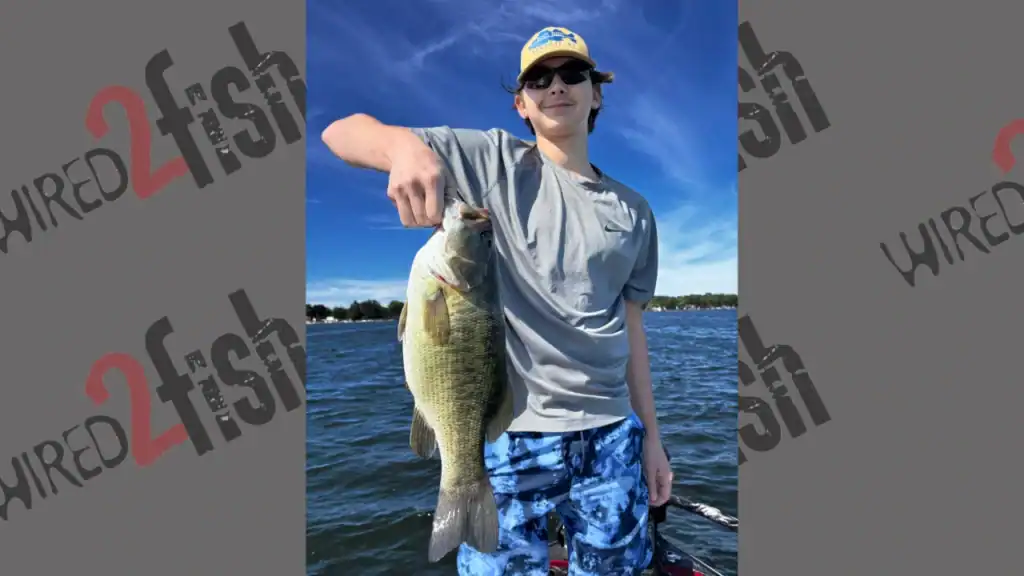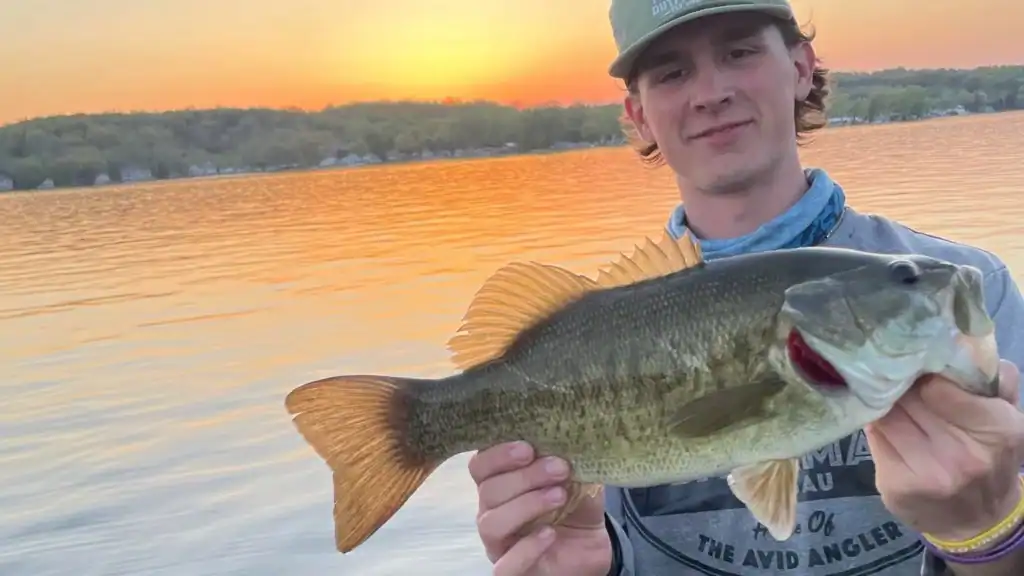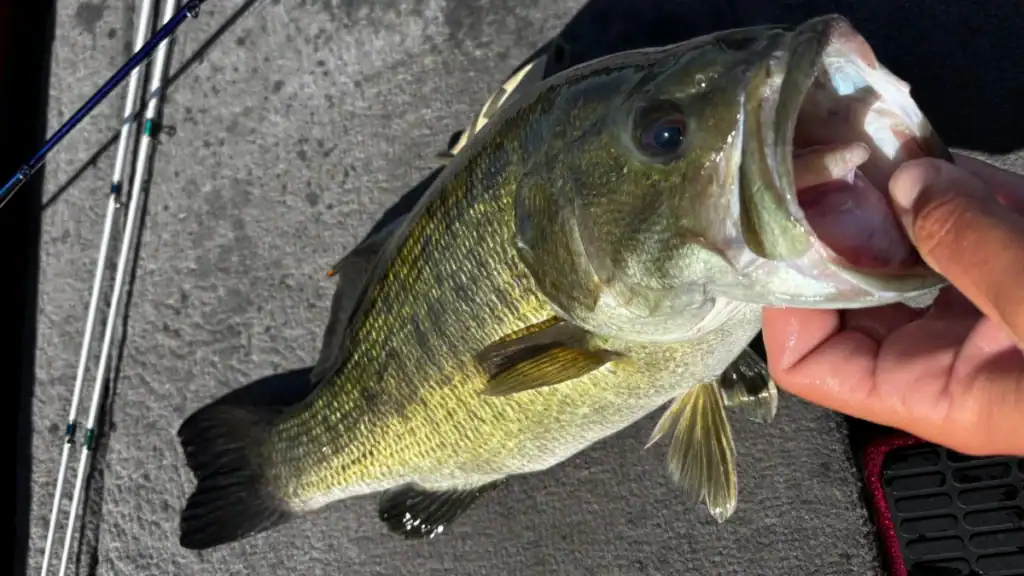Like on any guide trip, I never really know what to expect. Whether it’s my clients, the fish, or the weather, you just never know what you’re going to get. And on August 18, 2025, I certainly wasn’t expecting my client to land a super-rare fish.
As we left the boat ramp on Conesus Lake, the westernmost of the Finger Lakes in New York, we motored to a piece of hard structure that has been good to me in the past. We were targeting big northern pike, but a few bass were a welcome bonus. After getting the boat in position and spot-locked, I told 15-year-old Liam Fuller of Canandaigua, NY, to cast toward the structure.
A few chunky smallmouth bass hit the deck, but the next cast was one to remember. As he pitched a dropshot rig over the structure, his rod immediately doubled over. After a quick fight, I scooped up what I thought was a largemouth. But on closer inspection, the fish showed tell-tale signs of a different kind of fish—a fish so rare in the Northeast that it only appears every so often during the bass breeding season. This is a fish anglers search for their whole lives. I was jumping for joy and my inner fish nerd was showing out in a big way.
It was a meanmouth bass. You might be thinking, “Is this even real?” Many people questioned me on social media, but it’s absolutely real. Let’s discuss what makes this amazing bass so unique and rare.
What Is A Meanmouth Bass?

The meanmouth bass is, as its name suggests, a powerful fighter. It’s not a common species, but a rare hybrid born from the breeding of a largemouth (or spotted bass) with a smallmouth bass. Despite the fact that some freshwater fish are more likely to hybridize, a meanmouth is a truly unique catch. While their color can vary greatly, there are two key features to look for when identifying a meanmouth:
Jawline: Look at how the jaw aligns with the eye. A largemouth’s jaw extends past the back of its eye, while a smallmouth’s jaw doesn’t reach the middle of the eye. The jaw of a mean mouth bass falls perfectly in the middle, lining up with the back of the eye.
Dorsal Fin: The dorsal fin on top of a largemouth is split into two distinct parts. A smallmouth’s dorsal fin is fully connected. A meanmouth’s dorsal fin shows a subtle, almost-connected link between the two sections.
If you suspect you’ve caught a mean mouth, check for these traits. These fish are far rarer than many people realize and are often confused with weirdly colored largemouth bass.
The History Of Bass Hybridization

Researching old fisheries periodicals didn’t yield much on these hybrids, but the little I found was intriguing for a fish enthusiast like me. The history of bass hybridization traces back to the 1960s, when Dr. William Childers of the Illinois Natural History Survey began a study on the sunfish family (Centrarchidae). He wanted to know how many species, including bluegill, pumpkinseeds, and largemouth and smallmouth bass, could interbreed in the wild.
He discovered that largemouth and smallmouth bass wouldn’t hybridize when simply stocked into the same ponds. However, in a controlled lab environment, largemouth eggs fertilized with smallmouth milt produced live offspring. The resulting fish were almost always sterile, but they were also more aggressive than their parent species. In some cases, these hybrid bass were so feisty they would chase dogs and swimmers out of the ponds.
Another example comes from a peer-reviewed article by biologists Donald H. Whitmore and Thomas R. Hellier. In the mid-1970s, a similar event happened in Texas’s Squaw Creek Reservoir when smallmouth bass were stocked there. They soon began to naturally hybridize with the local largemouth bass. This suggests that introducing a new species of bass into a waterway may pose a greater risk for hybridization than if both species were already naturally present.
Where Can You Find Meanmouth Bass?

Hybridization of bass is most common in the southeastern United States, where a longer growing season and a prolonged spawning period increase the chances of a hybrid occurring. For example, waters where Alabama Spotted Bass were introduced into smallmouth fisheries also have potential to produce meanmouth bass.
Given this, catching a mean mouth bass in New York is exceptionally rare. This was the first one I’ve ever seen, and the only other one I’ve heard of was caught years ago by my friend Roy Bilby in Tupper Lake. The primary reason for this rarity is the Northeast’s short growing season. Our lakes are frozen for most of the winter, and bass spawn for only about three weeks each year. Additionally, predators like panfish and gobies are plentiful, which significantly reduces the survival rate of eggs. I’m convinced more of these fish exist in our waters, but finding one is like finding a needle in a haystack—they are true unicorns.
About The Catch

When Liam Fuller stepped onto my boat, I am sure he didn’t expect to catch a unique rare fish. Honestly, I wasn’t either.
Meanmouths surprisingly act more like smallmouths than anything. They prefer deeper, cleaner water with hard structure and baitfish. That is exactly where we were fishing. An artificial man made rock crib out in about 25 feet of water with baitfish all over the structure.
On my Garmin Livescope, I was able to spot bigger fish around the structure chasing the baitfish. Utilizing a dropshot rig with a live minnow (live bait is the most guaranteed way to get clients on fish in a short half day trip in the summer), it allowed the bait to be presented naturally. We spotlocked around 50 feet from the structure and cast toward it in order not to spook the fish.
I’m out on the water at least four to five days a week, whether it’s fishing or guiding, all over the Finger Lakes region and western NY. I see a lot of cool things on the water, but this is arguably the catch of the year in my book. To catch a fish that rare and large (the fish weighed 4.68 pounds) near my home is remarkable. Odds are we’ll both be playing lotto soon, hoping to continue our lucky streak.










